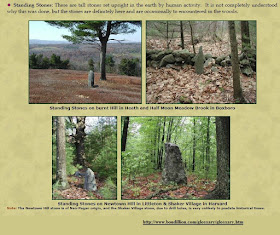Above are the two largest Equinox Stones while below is the Solstice Marker, the photos taken from the same place, looking east and north respectively (and respectfully).
Back in 1990 when
I first began to suspect that an Indigenous Cultural Landscape could be found “in
plain sight,” as they say, one of the first “notable stones” I came across was
a boulder that I suspected marked something, especially when two other boulders
and a series of smaller stones connecting them were taken into consideration.
Using some Boy Scout skills, backed up by some field observations during several
Spring or Vernal Equinox sunsets (the only time the event could be seen through
the leafless branches of trees), I also used a compass to complete the
triangulation that seemed to suggest that the Summer Solstice sunset was also “marked”
by the largest of the three boulders.
Looking back at the Stone (now knocked out of place) that was the "View Stone" from which I conjecture the Solar Events were originally observed to create the Ceremonial Stone Feature, perhaps to "Center One's Self in the Universe."
An old drawing that included the Solstice Standing Stone:
It's also a drawing that was inspired by this illustration from a local history, adding in some stone Burial Mounds that were destroyed/plundered in the mid 1800's:
I’d have to say that I was influenced by
the book Manitou by Mavor and Dix and this illustration:
I recall finding this from Dan Boudillion:
The phrase "Standing Stone" comes up often at the Rock Piles blog, and a search of the site will pull up many examples, including this one:
Twenty seven years
later, I find that I was not too far off base -and that an Indigenous term for this type of Ceremonial Landscape Feature is coming into use:
Above:“Sunśh nipámu - (‘marker stone’
Narragansett, Harris and Robinson 2015:140, viz. sunś,
‘stone,’ nipawu ‘stand up,’ Mohegan Nation 2004:100, 83) serve
as indicators...” Rolf Cachat-Schilling (2016) -


















No comments:
Post a Comment